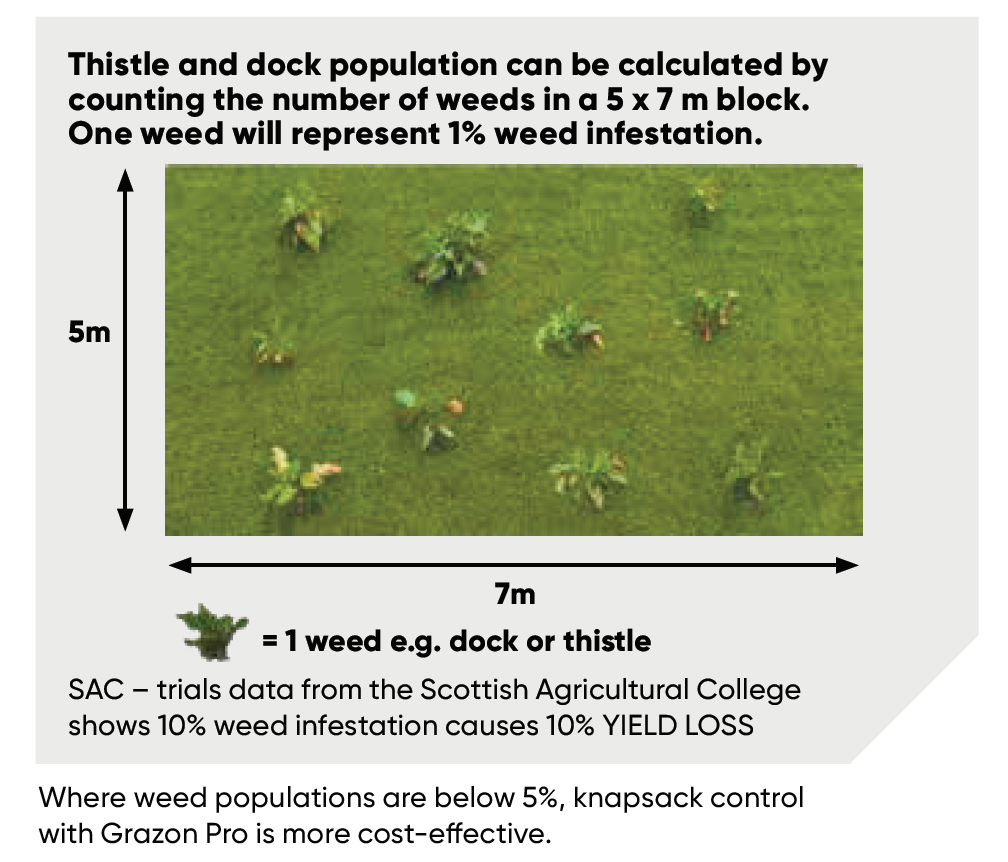


A very effective translocated product for both creeping and spear thistle. It is very safe to grass.
Thistles need controlling because:
• They compete with grass for space, light, nutrients and water
• They are unpalatable to stock
• They lead to greater incidence of Orf
• Reduce the available grazing.
Choose Thistlex because it:
• Delivers outstanding control of creeping thistle
and spear thistle, up to 85% control 12 months after
application
• Also has activity on common nettle and dandelion
• Is very safe to grass.
Best practice: application advice
We recommend application with at least 75% drift reducing nozzles (DRN).
DRN is typically an air inclusion nozzle which creates larger droplets that contain small bubbles of air. This coarser droplet enables the spray to travel accurately from nozzle to target. On impact the bubble bursts leaving smaller droplets across the leaf for absorption. This means less drift and more deposit of product on to the target leaf. Travelling speed and water volume will determine the exact type of nozzle to use:
• Make the application in at least 200 litres water/hectare.
• Optimal travelling speed when spraying grassland is typically in the range of 8 to 10kph depending on field conditions.

* Ragworth label guidance
Ragwort plants sprayed with this herbicide are more palatable and contain higher levels of toxins. Animals should be excluded from treated areas until any ragwort has completely recovered or died and there is no visible sign of the dead weed. Do not include treated ragwort in hay or silage crops.
Do not include treated ragwort in hay or silage crops.
THISTLES
Creeping Thistle
Cirsium arvense

A perennial that grows from seed or from root sections in the soil. Once established, the root mass can be greater than the plant above ground, competing effectively with
the grass.
• A creeping thistle can produce up to 5,300 seeds, remaining viable for 10-21 years.
• Even a root fragment can remain viable for several years.
• Spreads primarily by vegetative growth of roots. The root system can grow as much as 6m horizontally in one season,
with most patches spreading at the rate of 1-2 m/year.
Spear Thistle
Cirsium vulgare

A biennial that grows from seed, and in the first year often goes unnoticed, since it produces only a small rosette. In the second year the plant can grow to over a metre in diameter before flowering, posing a serious economic threat.
• Biennial plant.
• Grows from seed - forms a rosette in first year and flowers in second year.
• Produces a tap root up to 70cm long.
• Each plant produces up to 8000 seeds viable for up to 3 years.
• There can be as many as 16 million seeds/ha.
• Seed dispersed by wind up to 30m.
Why control Thistles?
• Established creeping thistle has extensive underground roots and competes strongly with grass.
• Spear thistle in the second year can spread to cover more than a square metre of ground, thus posing a serious threat to
pasture productivity.
• Low infestation of just 1% will justify treatment.
• I n addition, thistles can facilitate the spread of diseases such as orf in sheep and lambs.
Treatment options for Thistle control
• Topping may be appropriate as a first step treatment to get different growth stages to the same stage ready for treatment with a suitable translocated herbicide.
• Preferred solution when thistles are the primary target is Thistlex. If other weeds are also present use Forefront T, Pastor Trio or Grazon Pro.




News...
-

Thistles plunder grass yields and threaten animal health
Learn more... Thistlex
-

Advice on Effective Control of Thistles
Many thistle-infested grazing pastures are now at the ideal stage for treatment with an effective...
Talk to Us
If you would like further information on weed control and grassland management or wish to discuss your specific requirements please contact a member of our Technical team.


